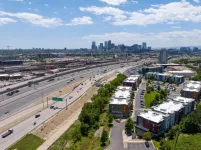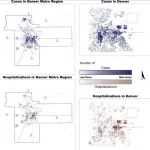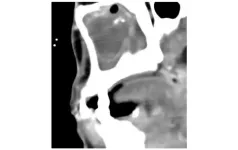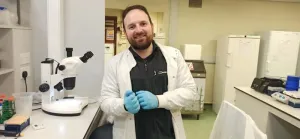The range of COVID-19 symptoms varies—some feel a mild cold, others are hospitalized, while others perish. Many studies have linked the severity of COVID-19 symptoms with an individual’s biological factors, but less is known about the impact of non-biological factors, such as the environment in which people live.
A new study that published on June 14, 2023, in the journal PLoS ONE, is the first to show that the neighborhood-built environment might pose an independent risk determining the individuals hospitalized due to COVID-19 illness.
The authors found that in a cohort of more than 18,000 individuals with SARS-CoV-2 infections, living in multi-family building, living in a neighborhood with higher air pollution (PM2.5) levels and living in a neighborhood with lower walkability and bike-ability were associated with a greater incidence rate of hospitalization, even when controlling for socioeconomic vulnerability and individual-level demographic and medical characteristics. Neighborhoods with higher public transit quality and access were also associated with a higher incidence rate of hospitalization.
The study identified differences between the two largest ethnic groups in the region. Higher PM2.5 levels posed a higher rate of hospitalization for Latinx individuals, and density and overcrowding showed stronger associations for non-Hispanic White individuals.
The findings could help inform public health and urban planning initiatives in lowering the risk of hospitalizations linked to COVID-19 and other respiratory pathogens.
“For urban planners, the findings underline what we’re already trying to do to build healthier communities—create more walkability, bike-ability and infrastructure that will reduce air pollution,” said Alessandro Rigolon, associate professor at the University of Utah and lead author of the study. “From a public health perspective, the findings can help testing and vaccination campaigns target areas with higher air pollution or multi-family housing.”
The study also exposed how urban policies from the past continue impact the daily lives of many communities.
“We found much higher rates of COVID-19 hospitalizations along the I-25 and I-70 corridors and in the industrial areas of North Denver,” said Jeremy Németh, professor at the University of Colorado Denver and co-author of the study. “These are the same areas that have experienced decades of disinvestment and increased air pollution due to racist land-use policies levied on our cities in the early 20th century.”
Neighborhood-built environments
The study analyzed the neighborhood characteristics in the Denver Metro Area associated with hospitalizations of 18,042 people who tested positive for SARS-CoV-2 between May and December in 2020, before vaccines became extensively available. Researchers from two of the Denver Metro Area’s major health care systems, Denver Health and University of Colorado Hospital, reviewed more than 30,000 cases of eligible individuals. They limited the cohort to those living in the greater metro area, and matched available health record data for each case. Variables pulled from the medical record included age and body mass index (BMI), evidence of tobacco use, hypertension, chronic lung disease, some forms of cardiovascular disease and chronic kidney disease. Researchers at the University of Colorado Denver then converted addresses of people in the final cohort to their geospatial coordinates and assigned environmental variables accordingly.
Ethical oversight and approval for the study was granted by the Colorado Multiple Institutional Review Board and all protected health information was anonymized prior to sharing.
“Very few studies are comprehensive like ours. We're able to control for some individual level factors that, for people with COVID-19, would lead to higher chances of being hospitalized,” said Rigolon.
With biological factors largely accounted for, the authors identified four characteristics of a neighborhood that might contribute to COVID-19 hospitalization: density and overcrowding, including living in an overcrowded home or multi-family building; environmental hazards, such as air pollution levels (PM 2.5) and proximity to highways; environmental amenities, including access to parks; and mobility options, including public transit access, walkability and bike-ability.
The authors were unsurprised that individuals with compromised lung and immune systems who face chronic air pollution would be unable to respond as well to the respiratory disease and would be more likely to need hospitalization after contracting COVID-19. Their finding that higher PM2.5 levels impacted Latinx individuals more than non-Hispanic White individuals underscores a worldwide problem—air pollution disproportionately affects People of Color. While findings support making existing neighborhoods more walkable and bikeable, the authors emphasized that future planning efforts to reduce emissions should center the principles of environmental justice. Since walkability was particularly protective in Latinx communities, the authors suggest that cities should prioritize investing to make Latinx-dominant neighborhoods pedestrian-friendly.
The result for density and overcrowding underscore the need for vaccination and testing efforts to focus on areas with multi-family housing to mitigate risk of severe disease. Because living in transit-rich neighborhoods was associated with higher risk of hospitalization from COVID-19, public health measures like educational campaigns and outreach in these areas are particularly important.
“So many health disparities track along geographic lines. We’ve long suspected that more than just pre-existing medical conditions were to blame for the disparities. It was interesting to work with the urban planning teams to pinpoint exactly which environmental factors were partially to blame for disproportionate rates of hospitalizations that we keep seeing. This will help public health leaders continue to advocate for healthier cities, and it helps inform outreach efforts to address COVID-19 and other respiratory illnesses,” said Sarah Rowan, associate professor of medicine at University of Colorado School of Medicine, Denver Health infectious diseases physician and the study’s senior author.
Neighborhoods in other areas, other diseases?
The authors would like to replicate this study in other regions such as in the Salt Lake Valley in Utah, which has similar environmental and population characteristics as the Denver Metro Area. They’d also like to expand to other respiratory diseases where people are hospitalized, such as the flu. Though it took multiple years to process the massive quantity of patient records, studies that can look at health outcomes and the built environment on an individual level are valuable.
“Urban planning was born out of public health concerns in the U.S. when cities were getting very crowded, very polluted and sanitation was an issue. It’s only natural that urban planners do research that involves public health,” said Rigolon.
Additional contributing authors include Brenn Anderson-Gregson, Ann Rae Miller and Priyanka deSouza of the Department of Urban and Regional Planning, University of Colorado Denver; Brian Montague and Kristine M. Erlandson of the Division of Infectious Diseases, University of Colorado School of Medicine; and Cory Hussain, University of Colorado School of Medicine and Denver Health.
END






